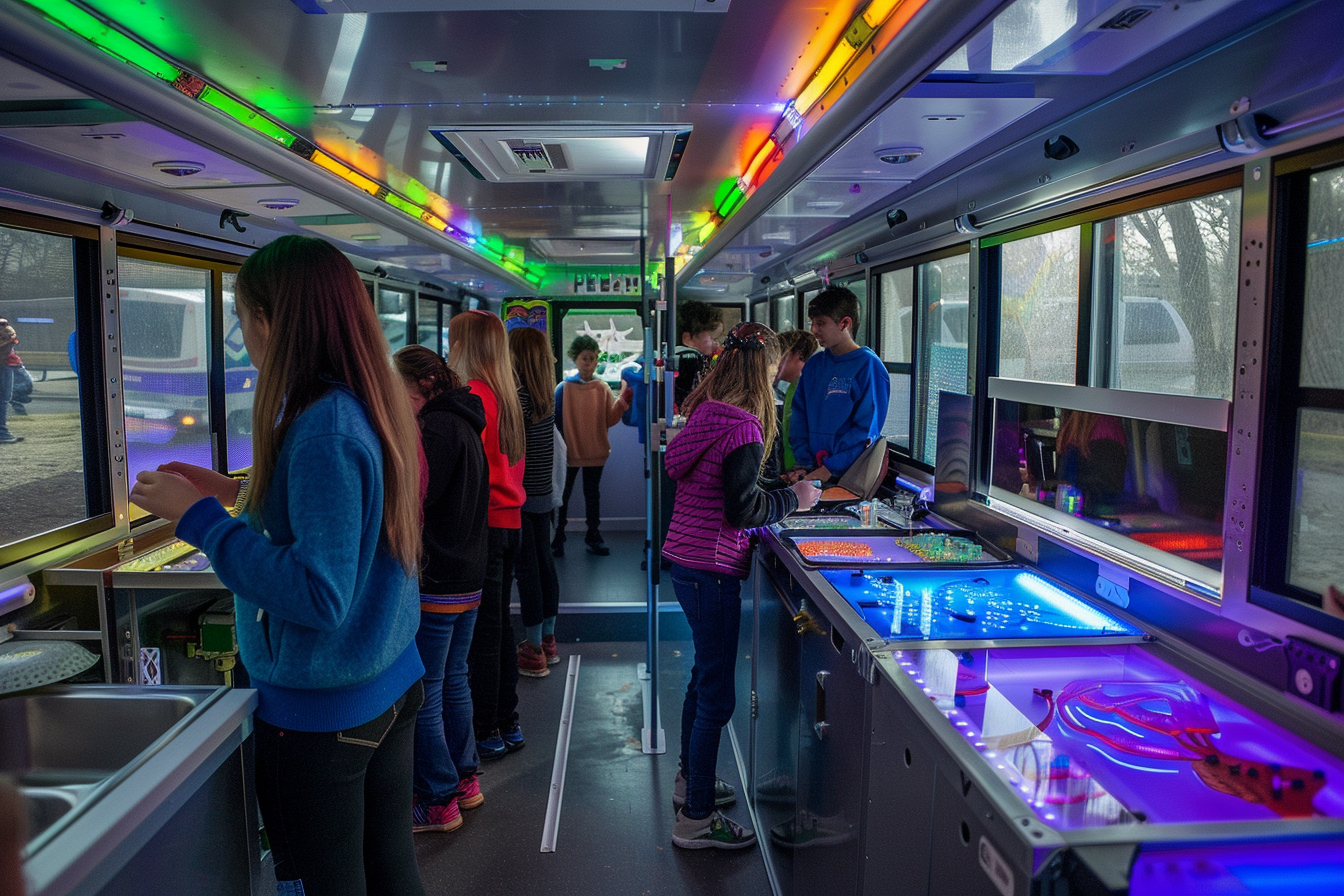Revolutionizing STEM Education: The Impact of Mobile Learning Labs
Discover how mobile learning labs bring immersive, hands-on STEM experiences to underserved communities, sparking students’ curiosity.

Imagine a classroom on wheels, where cutting-edge technology and hands-on STEM activities travel directly to students, sparking curiosity and excitement for learning. Mobile learning labs are transforming education by bringing high-quality STEM experiences to underserved communities, ensuring that all students have access to the tools and knowledge they need to succeed.
These innovative labs break down barriers to education by providing flexible, engaging, and accessible learning opportunities. As the demand for STEM education grows, mobile learning labs offer a unique solution to reach students who might otherwise be left behind. By delivering science, technology, engineering, and math directly to schools, community centers, and public events, these labs create dynamic and interactive learning environments.
We will explore the principles, benefits, and implementation strategies of mobile learning labs, highlighting their potential to revolutionize STEM education and inspire the next generation of innovators and problem solvers. Join us as we delve into this exciting educational initiative that is making a difference across the country.
Understanding Mobile Learning Labs
Mobile learning labs are innovative educational platforms designed to bring STEM (Science, Technology, Engineering, and Mathematics) education directly to underserved communities. These labs are typically housed in specially equipped vehicles, such as buses or trailers, and travel to various locations to provide hands-on learning experiences. The primary goal of mobile learning labs is to increase access to quality STEM education for students who might otherwise lack such opportunities.
Enjoy science fiction? Check out my space books HERE on Amazon!
The concept of mobile learning labs has evolved from traditional classroom settings, adapting to meet the needs of diverse populations. Initially, they were used to supplement existing educational programs, but they have grown in popularity as a standalone solution for delivering comprehensive STEM education. Core principles of mobile learning labs include accessibility, flexibility, and practical, hands-on learning. By bringing state-of-the-art equipment and resources to students, these labs help bridge the educational gap and inspire future generations to pursue careers in STEM fields.
Types of Mobile Learning Labs
Mobile learning labs come in various forms, each offering unique benefits and focusing on different aspects of STEM education. Here are some common types:
- STEM Labs on Wheels: These fully equipped vehicles bring comprehensive STEM education to schools and communities. They are designed to offer a wide range of activities, from science experiments to engineering projects.
- Mobile Science Labs: Focused on delivering hands-on science experiments and activities, these labs provide students with the opportunity to conduct experiments and engage in scientific inquiry.
- Technology-Focused Labs: These labs provide access to computers, coding equipment, and digital learning tools. They emphasize the development of technological skills, including programming and digital literacy.
- Engineering and Robotics Labs: Offering practical engineering projects and robotics programs, these labs allow students to design, build, and test their creations, fostering problem-solving and critical thinking skills.
- Hybrid Mobile Labs: Combining virtual and physical resources, hybrid mobile labs maximize learning opportunities by integrating online content with hands-on activities. This approach offers flexibility and caters to diverse learning needs.
By exploring these types of mobile learning labs, educators and communities can find models that best fit their educational goals and local needs.
Benefits of Mobile Learning Labs
Mobile learning labs offer numerous advantages, making them an effective solution for enhancing STEM education in underserved communities. Here are some key benefits:
- Increased Access to STEM Education: By bringing resources directly to students, mobile learning labs ensure that all students, regardless of their location, have access to quality STEM education.
- Hands-On Learning Experiences: Mobile labs provide practical, real-world applications of STEM concepts, engaging students and enhancing their understanding of complex subjects.
- Flexibility and Convenience: These labs can travel to various locations, offering education in diverse settings, such as schools, community centers, and public events.
- Community Engagement: Mobile learning labs involve local communities in educational initiatives, fostering collaboration and support for STEM education.
- Inspiring Future Careers: By exposing students to STEM fields and providing hands-on experiences, mobile labs spark interest in STEM careers and encourage students to pursue related studies and professions.
These benefits highlight the potential of mobile learning labs to transform STEM education and provide valuable opportunities for students in underserved areas. By understanding these advantages, educators and administrators can better appreciate the value of mobile learning labs in promoting STEM education and student success.
Implementing Mobile Learning Labs
Implementing mobile learning labs requires careful planning and collaboration. The first step is developing a clear vision and structure for the mobile lab, which includes defining its goals, identifying target communities, and outlining the activities that will take place. Involving educators, students, parents, and community members in this process ensures that the initiatives meet the needs and values of all stakeholders.
Curriculum development is crucial. Creating a flexible and engaging STEM curriculum that aligns with educational standards and caters to diverse learning needs is essential. Incorporating hands-on activities, project-based learning, and technology integration can enhance the learning experience.
Partnerships and funding are vital for the success of mobile learning labs. Securing support from businesses, organizations, and government agencies can provide the necessary resources and financial backing. Developing a sustainable funding model and seeking grants and donations can help maintain long-term operations.
Logistics and scheduling need to be carefully planned. Organizing routes, schedules, and locations to maximize impact and reach the target communities is essential. Flexibility in scheduling can accommodate various educational settings and community events.
Training and professional development for educators are also important. Ensuring that teachers are equipped to deliver high-quality STEM education and manage the mobile lab effectively is crucial. Providing ongoing training and support helps teachers stay updated with best practices and new approaches.
Overcoming Challenges in Mobile Learning Labs
Implementing mobile learning labs comes with its own set of challenges, but these can be effectively managed with strategic planning and collaboration. One major challenge is securing funding and resources. Finding financial support through grants, donations, and community partnerships can help sustain the mobile lab’s operations.
Ensuring sustainability is another concern. Developing sustainable models for long-term success requires careful planning and ongoing evaluation. Establishing clear goals, metrics, and regular assessments helps ensure the mobile lab’s impact and effectiveness.
Equipment maintenance is crucial. Keeping technology and equipment in good working order requires regular checks, updates, and repairs. Developing a maintenance schedule and having a dedicated team for equipment upkeep can help manage this challenge.
Addressing diverse needs is important. Adapting programs to meet the varied needs of different communities and students ensures that the mobile lab is inclusive and effective. Customizing activities and resources can enhance the learning experience for all participants.
Measuring impact is essential. Tracking the effectiveness and outcomes of mobile lab programs through data collection, feedback, and assessments helps demonstrate their value and guide future improvements.
Case Studies
Implementing mobile learning labs has led to notable successes in various educational settings across the country. Here are three case studies highlighting the impact of these methods:
Case Study 1: STEM Mobile Lab in Texas
A STEM mobile lab in Texas traveled to rural schools, providing students with hands-on STEM activities and experiments. The lab included equipment for robotics, coding, and engineering projects. Students reported increased interest in STEM subjects, and teachers observed improved engagement and performance in science and math.
Case Study 2: Mobile Science Lab in Ohio
A mobile science lab in Ohio focused on delivering practical science experiments to schools in underserved areas. The lab offered activities such as chemistry experiments, biology dissections, and physics demonstrations. The initiative not only enhanced students’ understanding of scientific concepts but also inspired many to pursue further studies in science.
Case Study 3: Technology-Focused Mobile Lab in Alabama
In Alabama, a technology-focused mobile lab provided students with access to computers, coding equipment, and digital learning tools. The lab offered workshops on programming, digital literacy, and cybersecurity. Students gained valuable skills in technology and digital media, which prepared them for future careers in the tech industry.
Practical Tips for Educators and Administrators
Implementing mobile learning labs can be straightforward with the right approach. Here are some practical tips for educators and administrators to consider:
- Start Small: Begin with a pilot program to test and refine the concept. This allows for adjustments based on initial feedback and results.
- Leverage Local Resources: Utilize community expertise and resources to enhance learning experiences and reduce costs. Partnering with local businesses and organizations can provide additional support and materials.
- Focus on Engagement: Design programs that actively involve students in hands-on learning. Interactive and practical activities can enhance student interest and retention of STEM concepts.
- Promote Collaboration: Foster partnerships with schools, businesses, and organizations to expand the reach and impact of the mobile lab. Collaborative efforts can provide a wider range of resources and opportunities.
- Continuously Evaluate: Regularly assess the program’s impact and make necessary adjustments. Collecting feedback from students, teachers, and community members helps ensure the program meets its goals and continues to improve.
These tips can help educators and administrators create a successful and sustainable mobile learning lab that benefits students and communities.
Future Trends in Mobile Learning Labs
The future of mobile learning labs is evolving, with new trends enhancing their effectiveness and reach. Advanced technology integration, such as augmented reality (AR), virtual reality (VR), and artificial intelligence (AI), is becoming increasingly prevalent. These technologies can provide immersive and interactive learning experiences, making STEM education more engaging and effective.
Expanding the reach of mobile learning labs is another trend. Increasing the number of mobile labs and their coverage areas ensures that more students have access to quality STEM education. Developing partnerships with other regions and organizations can help achieve this goal.
Check out our engaging printable posters. CLICK HERE to explore!
Global collaboration is also emerging as a significant trend. Connecting mobile labs with international programs for shared learning and projects can broaden students' perspectives and foster global awareness.
Sustainability practices are gaining importance. Implementing eco-friendly practices in mobile lab operations, such as using renewable energy sources and reducing waste, aligns with broader environmental goals.
Personalized learning is a growing focus. Using data and analytics to tailor programs to individual student needs can enhance the effectiveness of mobile learning labs and ensure that all students benefit from the initiatives.
By staying updated with these trends, mobile learning labs can continue to innovate and provide high-quality STEM education for students.
Conclusion
Mobile learning labs are revolutionizing STEM education by bringing hands-on, practical learning experiences directly to underserved communities. By providing increased access to quality STEM education, engaging students with real-world applications, and fostering community involvement, these innovative labs have the potential to inspire future generations of scientists, engineers, and technology professionals.
As education continues to evolve, mobile learning labs offer a flexible and effective solution for addressing educational disparities. By overcoming challenges such as funding, sustainability, and equipment maintenance, and by staying attuned to future trends like advanced technology integration and personalized learning, mobile learning labs can continue to expand their reach and effectiveness. Embracing these innovative educational platforms will help ensure that all students, regardless of their location or background, have the opportunity to explore and excel in STEM fields.
Check out some of my latest science fiction books HERE on Amazon!
Transform your classroom into an inspiring and vibrant learning space with our beautifully designed printable posters! Perfect for engaging your students and enhancing your teaching environment, our poster bundles cover everything from historical philosophers to animals. CLICK HERE to explore our exclusive collections on Teachers Pay Teachers and give your students the motivational boost they need!
